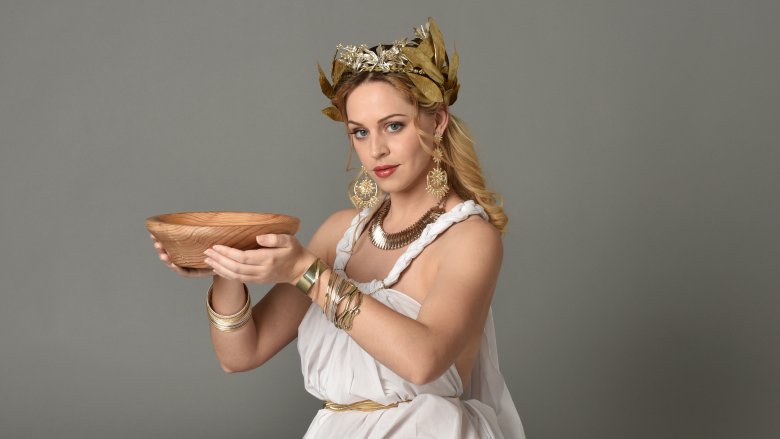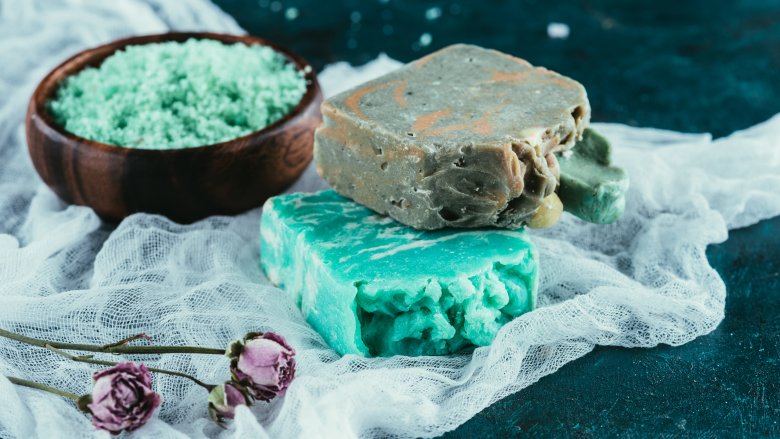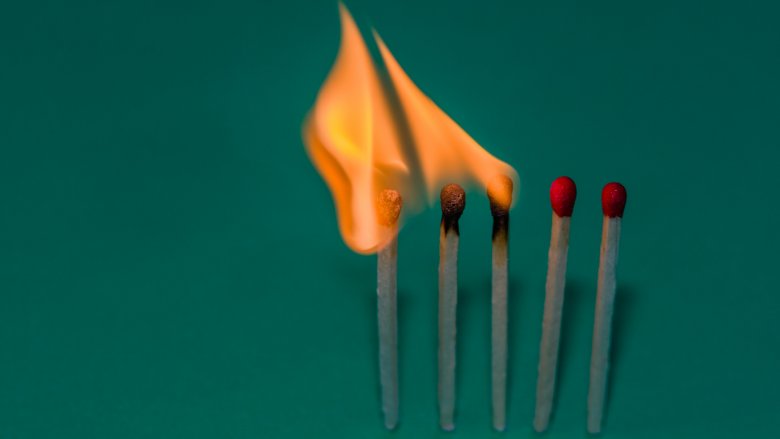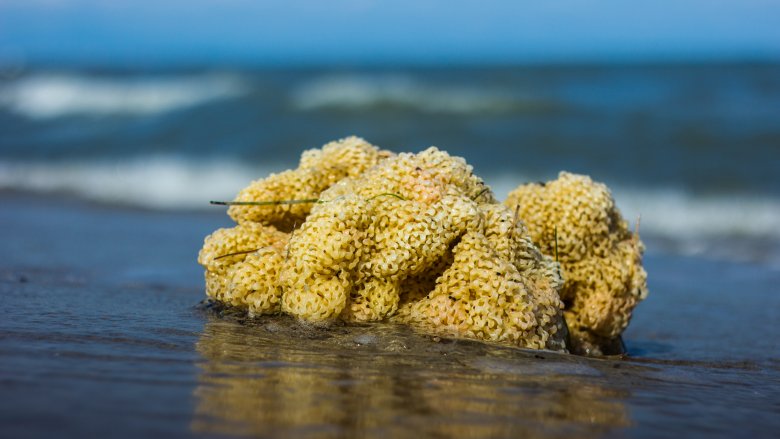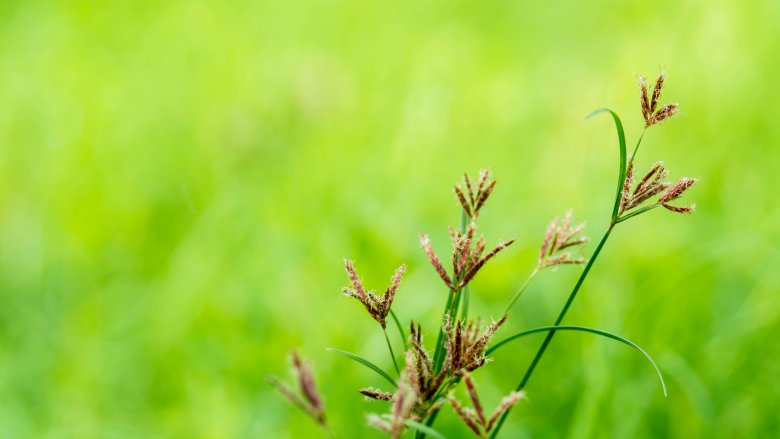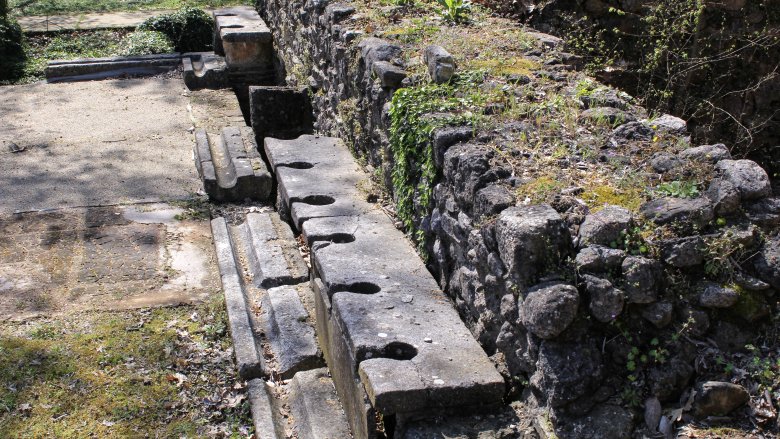Bizarre Things About Cleaning Our Ancestors Believed
There are a lot of things you shouldn't judge a person on, but cleanliness can be one of the legit factors for basing an opinion. But there are a lot of cultural differences in this area, too. What's normal in one country might be weird in the next, and what goes on behind closed doors? That's anyone's guess.
Just take Flint + Flint's 2015 survey of more than 2,000 British women (via The Telegraph). They found that four out of five didn't shower every day, a third went three days before hopping in the bath, and one in eight went to bed without brushing their teeth first. Many cited fear of not getting enough sleep before they have to get up in the morning as their reason for skipping some nightly cleaning, and that might say more about our modern-day society than the habits of British women.
That's just a bit of weird in today's world. Go back through history and you'll find our ancestors had plenty of even weirder ways of keeping themselves clean. They definitely don't show this stuff in period dramas.
Ancient Rome: Using urine for ... what?
Discovering the little details of the everyday life of our ancestors can be a bit tricky, but fortunately, the ancient Romans left behind a ton of writing — and they weren't shy. The poet Catullus once wrote about how nice it was to brush your teeth with urine.
The Smithsonian says it was the ammonia in urine that acted as a bleaching agent, leading to those oh-so-desirable pearly whites. It's possible they refined the urine into ammonia before guzzling it down, of course, so let's all just hope.
Everyone's familiar with the idea of the Roman bath, and archaeologists are still learning about what went on there. According to researchers from the University of Iowa (via LiveScience), artifacts recovered from pool drains included plenty of hygiene objects — perfume vials, oil flasks, and nail cleaners — but they've also recovered some teeth, too. There were enough teeth that they think Romans were going to baths for socializing, pampering, and some dentistry at the same time. Rinse and spit!
Ancient Rome: Getting out those tough stains
The Romans might be known for their baths, but keeping the body clean was just part of it. They needed to keep those clothes clean, too, and at some point, someone discovered the ammonia in urine was great for keeping those whites whiter and those colors brighter.
William Smith described the process in A Dictionary of Greek and Roman Antiquities, and it makes doing laundry today look like cake. Most Romans wore wool, and given how hot it is in Italy, they needed a lot of washing. An ancient Roman laundromat was called a fullonica, and it was staffed by fullones. It was their job to stomp on clothes in vats of liquid to wash them, and that liquid was most commonly a mix of animal and human urine. Collecting all that urine was a part of the fullones' job, too. Most often, they were seen standing on street corners with a bucket, hoping passers-by would take the opportunity to relieve themselves.
After washing, white clothes would be further whitened by being hung in a basket over sulfur fumes, and that just goes to know that no matter how much scholars think they know about the past, they still can't even begin to imagine how it must have smelled.
Wei dynasty: Bath beans for cleanliness
Somewhere around 3,000 years ago, people living in China were developing methods of using plant ash to remove the toughest of grease stains, and according to The Epoch Times, this was a combination of cleanliness and religion. For a long time, the water left over from cooking rice would be used for bathing, but by around 420 they developed bathing beans. They were made from all sorts of things, and according to the writings of a Sui and Tang dynasty doctor named Sun Simiao, the pancreas of a pig was a common ingredient.
After draining the blood from the pancreas, it was mixed with plaster, bean powder, and fragrance. The resulting "bean" was used for both skin and clothing, and would have been recognizable to us as soap — even down to the foaming action. Sun Simiao recommended different ingredients for people of different status, and the higher ranking you were, the more ingredients your bath bean would have had. His Supplement to the Formulas of a Thousand Gold Worth listed a ton of different combinations, and some had dozens of ingredients. With that many combinations it's not entirely surprising that some of them were caustic, and it's proof that just because it makes suds, that doesn't mean you should wash your face with it.
Ancient Greece to the Middle Ages: Sulfur dioxide for cleanliness
The smell of sulfur dioxide is unmistakable — it's the smell of hot, rotten eggs. The Australian government says most of the bad effects — aside from the eye-watering stench — are respiratory, but it wasn't always considered a problem. Starting in ancient Greece, it was used to purify homes.
The first mention we have of it comes from Homer's Odyssey. When Odysseus kills some rivals, he asks their home be purified by burning sulfur inside so the house is fit for people who were not so horrible.
The use of burning sulfur was widespread, and this stinky gas was used for a number of reasons. In India, it was burned in rooms were operations and surgeries were going to be held, in order to purify the air. It was still being used during the Middle Ages, too, and sulfur was burned in homes and buildings were residents had died from the plague or other diseases. The logic was strange: Scholars think it started when people observed sulfur fumes killing plants and small animals, so they figured it must kill other tiny things, too. They ... were right?
Early 20th century: Spray Lysol where?
Bizarre beliefs about cleanliness aren't just found in the ancient world. Just a few decades ago, an insanely dangerous practice was marketed toward women. In the first half of the 20th century, Lysol was branded as both an effective douche and a form of birth control. Yes, that's the stuff used to kill germs on surfaces today, and pre-1953, it was even more dangerous. That early recipe contained cresol, which Mother Jones says was linked to things like burns and death ... but women were still being encouraged to use that to clean up their lady gardens.
At the same time it was being marketed as a great way to keep your hoo-ha clean, it was also being marketed as a treatment for ringworm and a germicide great for keeping toilets sparkling. It's unclear just what advertisers thought was going on down there, but they continued to push Lysol as a feminine hygiene product for decades after it was found to be not only ineffective, but dangerous. Through the 1940s, it was actually the country's most popular birth control method, even though it had been linked to deaths as early as 1911. Lawsuits had been filed in the 1930s after women started claiming Lysol was giving them burns, but the manufacturers were cleared and sales continued.
Ancient Greece and Rome: Scrape off that dirt and oil
A little elbow grease goes a long way, right? Sure, but no one's talking about actual grease today. At one point, they were.
According to the J. Paul Getty Museum, ancient Greco-Roman athletes cleaned up in a sort of counterintuitive way. Before they headed off to the baths to use some more traditional soap and water, they scrubbed up with oil and an abrasive. Sand and ground pumice were common, and once they were covered with that oily mess they'd scrape it off with a curved tool called a strigil. Both men and women did it, and it was one of the most important tools in any athlete's arsenal. They'd usually oil themselves up before heading to the gym, and once they were done, they'd clean off the worst of the oil, sweat, dirt, and blood with the strigil.
It actually gets worse. According to Health and Fitness History, everyone used a strigil but the muck athletes scraped off themselves was thought to be extra special and have some sort of medicinal power. It was often saved and used as an ingredient in salves and poultices, which had to make working in an ancient apothecary extra nasty.
Ancient Rome: Butt brushes
Toilet paper is one of those inventions that doesn't get much of a second thought today, and it's easy to forget how modern is actually is. The idea has been around since at least 14th-century China (via ABC), but it took centuries it to catch on. Two-ply only showed up in the 1940s, and it was advertised as something everyone should probably be using by the 1960s. So what happened before that?
Colonial Americans used corncobs, and old newspapers and catalogs were popular options in the early 1900s. Ancient Rome has perhaps the most questionable method for cleaning your exhaust port, and the icky starts with the fact they had very public toilets. Archaeologist Stephen E. Nash says (via Sapiens) that researchers know a lot about Roman toilet habits thanks to the facilities and frescoes preserved at Pompeii, and that includes the closely positioned toilet holes and illustrations of the tersorium. Essentially, this Roman-era toilet paper was a sea sponge (like the one above) on a stick, which people would use to wipe themselves after doing their business. And no, people didn't carry their own personal sponges with them — they were just as public as the toilets. If running water wasn't handy, buckets of salt water and vinegar would be left by the toilets, so people could rinse off their sponges before leaving them for the next person. They definitely don't show that on TV.
Ancient Sudan: Chomping on weeds
Dentists have always been pretty horrible, and that means people have always tried to take care of their teeth so they didn't get to a point where they needed to have their neighbor knock some out with a rock. (Not kidding.) Mankind had pretty decent teeth until farming and carbs started, but strangely, people living in the Sudan around 2,000 years ago had shockingly great teeth. Only about 1 percent of them had a cavity or signs of tooth decay, and it wasn't until 2014 that researchers figured out why.
According to National Geographic, their fine chompers were a consequence of chewing on one of the most noxious, invasive weeds in the world: purple nutsedge. Dr. Mark Schonbeck of the Virginia Association for Biological Farming says it's native to tropical Eurasia but has since spread around the world — and that's not a good thing for native plants. It's an invasive pest, but modern humans might want to take a page out of the book of the ancients.
Modern research has found that the extracts released when purple nutsedge is chewed destroys the same bacteria that causes cavities and tooth decay, but there's a catch: It tastes terrible. Researchers are pretty sure people weren't chewing it for the flavor, but suspect they knew it had medicinal benefits. Whether they knew that benefit was excellent dental hygiene, no one's sure.
Ancient Greece/Rome: Wiping with the names of your enemies
Most modern people wouldn't last a week having to use ancient hygiene methods, but there's one cleaning tool from ancient Greece and Rome that still has a certain appeal to it.
In the 1960s, archaeologists were excavating ancient Roman sites in England, and when they got to the toilets (like the ones pictured), they uncovered a series of small stone disks called pessoi. They were originally thought to be game pieces, but further research (and the Greek saying, "Three stones are enough to wipe") suggests they were actually a sort of reusable toilet paper (via Italy). It gets better.
According to Scientific American, some of the pessoi started out as ostraca. Ostraca are broken pieces of ceramic that people would etch with the names of others they just didn't like, and they were usually used in voting to banish someone from town. Later, it looks like they were recycled and used to clean up after using the toilet. How satisfying must it have been to use stones etched with the names of your enemies for a clean-up on Aisle Two?
19th-century France: 'The prophylactic power of dirt'
The French get a lot of hygiene jokes thrown their way, but according to a study published in Chicago Journals, there's a weird reason for that. When much of France was destroyed during World War II, they saw a much-needed "hygiene revolution" with the rebuilding of their cities. Before that, laundry days happened maybe twice a year, and it was believed that a good day of hard labor was all the cleaning the body needed. The stronger the body odor a person had, the healthier they were thought to be, and the lower classes held dirt and sweat in the highest regard.
When it came to the upper classes, there was something different at work. Modesty was of utmost importance, and the idea that someone would touch the most private places of their own body to wash them was met with something akin to shocked horror. Those that did bathe did so with their clothes — or at least underclothes — on, but most people only washed their hands and face. Nuns were forbidden from washing anything above their ankles, and the French aversion to touching oneself to wash was a huge hindrance in getting them to catch up to the rest of the world's idea of cleanliness. In 1865, there was a law passed that made teachers responsible for teaching students why it was important to change their underwear at least every few days. Those are important lessons.


